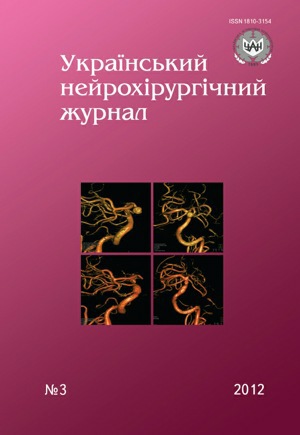Preoperative embolization of the vessels, supplying primary brain tumors
DOI:
https://doi.org/10.25305/unj.60839Keywords:
neurooncology, brain tumor, embolization, devascularization, angiographyAbstract
Introduction. The problem of operations performing at brain tumors of difficult topographic localization and intensive blood supply requires search of new methods for it’s solving.
Methods. Indications for tumor devascularization are: hypervascular vasculature available for embolization. After determination of target-vessels embolization was performed.
Results. In 92% observations effective devascularization of tumor node was achieved. In 17 (65%) patients embolization was considered as total, in 7 (27%) — significant part of tumor vasculature was occluded, in 2 (8%) — embolization was acknowledged as sufficient.
Conclusions. This method allows to decrease the blood loss during surgical removing of extra-intracerebral tumors with intensive blood supply. This gives an opportunity to perform more radical and less traumatic surgery.
References
1. Svistov DV, Kandyba DV, Savello AV. [et al.]. Predoperatsionnaya embolizatsiya vne- i vnutricherepnykh opukholey [Preoperative Embolization of Extra- and Intracranial Tumors]. Neyrokhirurgiya. 2007;2:24–37. Russian. http://www.neuro.neva.ru/RNOnline_22/English/Issues/Articles_1_2004/svistov.htm
2. Tigliyev GS, Olyushin VE, Kondratyev AN. Vnutricherepnyye meningiomy [Intracranial meningiomas]. St. Petersburg: Izd-vo RNKHI im. prof. A.L. Polenova, 2001. Russian.
3. Parfenov VE, editor. Sbornik lektsiy po aktualnym voprosam neyrokhirurgii [Collection of lectures on topical issues of neurosurgery]. St. Petersburg: ELBI-SPb; 2008. Russian.
4. Ben-Shaaban Abdulkhamid Yunis. Metody interventsionnoy neyroradiologii v neyroonkologii [Methods of Interventional Neuroradiology at neurooncology] [dissertation]. St. Petersburg (Russia); 2006. Russian.
5. Burtsev Ye M, Korotkov NI, Grabkin OS. Predoperatsionnaya aproksimalno-distalnaya embolizatsiya meningososudistykh opukholey golovnogo mozga embosilom s zhelezom i ferromagnitnoy zhidkostyu v magnitnom pole. In: Abstract Book of the V International Symposium «Povrezhdeniya mozga (minimalno-invazivnyye sposoby diagnostiki i lecheniya)». St. Petersburg, Russia; 1999. Russian.
6. Nikiforov BM, Teplitskiy FS. Klinika i khirurgiya vnemozgovykh opukholey [Clinic and Surgery extracerebral tumors]. Leningrad; 1981. Russian.
7. Khilko VA, Sikorskiĭ GI. [A method of embolizing branches of the external carotid artery as a step in the single-stage removal of intracranial arachnoendotheliomas]. Vopr Neirokhir. 1974;2:8-11. Russian. [PubMed]
8. Tsai E, Santoreneos S, Rutka J. Tumors of the skull base in children: review of tumor types and management strategies. Neurosurgical Focus. 2002;12(5):1-13. [CrossRef] [PubMed]
9. Dowd C, Halbach V, Higashida R. Meningiomas: the role of preoperative angiography and embolization. Neurosurgical Focus. 2003;15(1):1-4. [CrossRef] [PubMed]
10. Hart J, Davagnanam I, Chandrashekar H, Brew S. Angiography and selective microcatheter embolization of a falcine meningioma supplied by the artery of Davidoff and Schechter. Journal of Neurosurgery. 2011;114(3):710-713. [CrossRef] [PubMed]
11. Svistov DV, Ben Shaban AU, Kandyba DV. Morfologicheskiye izmeneniya pri embolizatsii sosudistoy seti gipervaskulyarizirovannogo novoobrazovaniya na modeli pochki zhivotnogo: eksperimentalnoye issledovaniye [Morphological changes after vascular bed embolization of hypervascularized tumor on rabbit kidney experimental model]. Vestn. Ros. voyen.-med. akad. 2006;2:87–93. Russian.
12. Tonn JC, Westphal M, Rutka JT, Grossman SA, editors. Neuro-Oncology of CNS Tumors. Berlin; Heidelberg: Springer–Verlag; 2006. [CrossRef]
Downloads
Published
How to Cite
Issue
Section
License
Copyright (c) 2012 Vladimir Pyatikop, Yuri Kotlyarevskiy, Igor Kutovoy, Yuliya Sergienko, Anton Pshenichny, Andrey Naboychenko, V. Levinsky

This work is licensed under a Creative Commons Attribution 4.0 International License.
Ukrainian Neurosurgical Journal abides by the CREATIVE COMMONS copyright rights and permissions for open access journals.
Authors, who are published in this Journal, agree to the following conditions:
1. The authors reserve the right to authorship of the work and pass the first publication right of this work to the Journal under the terms of Creative Commons Attribution License, which allows others to freely distribute the published research with the obligatory reference to the authors of the original work and the first publication of the work in this Journal.
2. The authors have the right to conclude separate supplement agreements that relate to non-exclusive work distribution in the form of which it has been published by the Journal (for example, to upload the work to the online storage of the Journal or publish it as part of a monograph), provided that the reference to the first publication of the work in this Journal is included.









